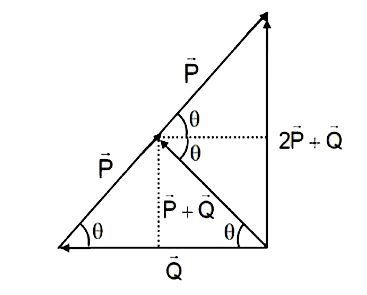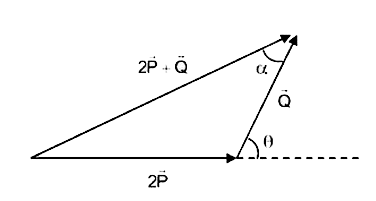The sum of two forces →P and →Q is →R such that ∣∣→R∣∣=∣∣→P∣∣. The angle θ (in degrees) that the resultant of 2→P and →Q will make with →Q is , _____________.
Video Solution
Text Solution
The correct Answer is:90

So angle between (2→P+→Q) is 90∘
∣∣→P+→Q∣∣=∣∣→P∣∣
P2+Q2+2PQcosθ=P2
⇒Q+2Pcosθ=0
⇒cosθ=−Q2P

tanα=2Psinθ2Pcosθ+Q=∞∴
[2Pcosθ+Q=0]
α=90∘
|
Topper's Solved these Questions
Similar Questions
The sum of two forces →P and →Q is →R such that ∣∣→R∣∣=∣∣→P∣∣. The angle θ (in degrees) that the resultant of 2→P and →Q will make with →Q is , _____________.
View SolutionMagnitude of resultant of two vectors →P and →Q is equal to magnitude of →P . Find the angle between →Q and resultant of →2P and →Q .
View Solution
Knowledge Check
What is the angle between →P and the resultant of (→P+→Q) and (→P−→Q)
AZeroBtan−1(P/Q)Ctan−1(Q/P)Dtan−1(P−Q)/(P+Q)Two vectors →Pand→Q are inclined to each other at angle θ. Which of the following is the unit vector perpendicular to →Pand→Q ?
A→P×→QP⋅QBP׈QsinθCˆP׈QPQsinθDˆP×→QPQsinθThe resultant of →P and →Q is perpendicular to →P. What is the angle between →P and →Q
Acos−1(P/Q)Bcos−1(−P/Q)Csin−1(P/Q)Dsin−1(−P/Q)
For any two vectors →p and →q, show that |→p.→q|≤|→p||→q|.
View Solution∣∣→P∣∣=∣∣→Q∣∣,∣∣→P+→Q∣∣=∣∣→P−→Q∣∣.Find the angle between P and Q
View Solutionif ∣∣→P+→Q∣∣=∣∣→P∣∣+∣∣→Q∣∣ , the angle between the vectors →Pand→Q is
View SolutionIf ∣∣→P+→Q∣∣=∣∣→P∣∣−∣∣→Q∣∣ , the angle between the vectors →Pand→Q is
View SolutionThe resultant of two vectors →Pand→Qis→R. If the magnitude of →Q is doudled, the new resultant becomes perpendicuar to →P. Then the magnitude of →R is :
View Solution
